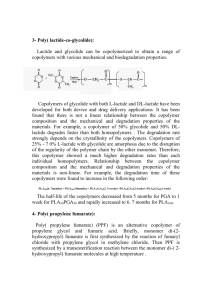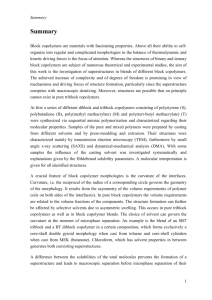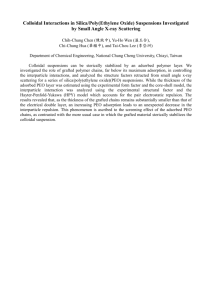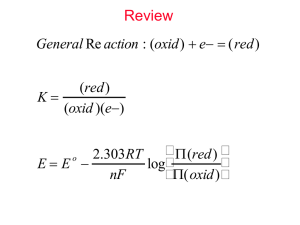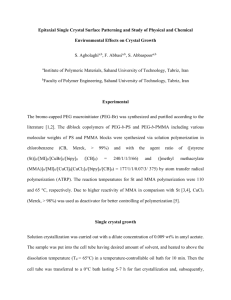Preparation and Characterization of Polystyrene
advertisement
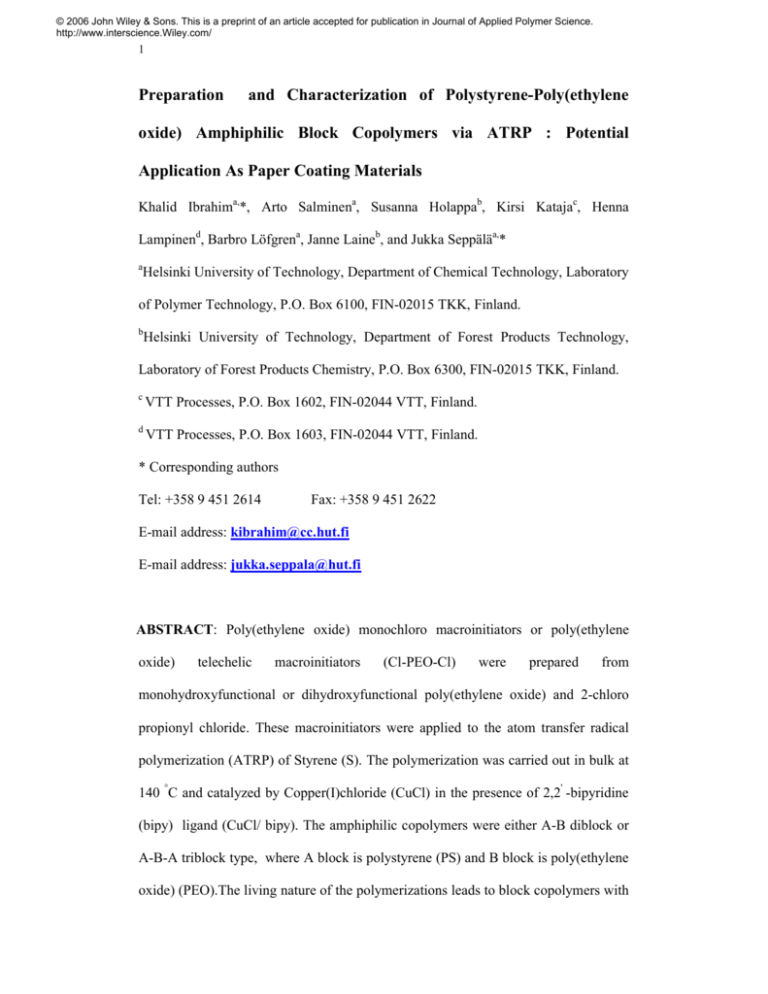
© 2006 John Wiley & Sons. This is a preprint of an article accepted for publication in Journal of Applied Polymer Science. http://www.interscience.Wiley.com/ 1 Preparation and Characterization of Polystyrene-Poly(ethylene oxide) Amphiphilic Block Copolymers via ATRP : Potential Application As Paper Coating Materials Khalid Ibrahima,*, Arto Salminena, Susanna Holappab, Kirsi Katajac, Henna Lampinend, Barbro Löfgrena, Janne Laineb, and Jukka Seppäläa,* a Helsinki University of Technology, Department of Chemical Technology, Laboratory of Polymer Technology, P.O. Box 6100, FIN-02015 TKK, Finland. b Helsinki University of Technology, Department of Forest Products Technology, Laboratory of Forest Products Chemistry, P.O. Box 6300, FIN-02015 TKK, Finland. c VTT Processes, P.O. Box 1602, FIN-02044 VTT, Finland. d VTT Processes, P.O. Box 1603, FIN-02044 VTT, Finland. * Corresponding authors Tel: +358 9 451 2614 Fax: +358 9 451 2622 E-mail address: kibrahim@cc.hut.fi E-mail address: jukka.seppala@hut.fi ABSTRACT: Poly(ethylene oxide) monochloro macroinitiators or poly(ethylene oxide) telechelic macroinitiators (Cl-PEO-Cl) were prepared from monohydroxyfunctional or dihydroxyfunctional poly(ethylene oxide) and 2-chloro propionyl chloride. These macroinitiators were applied to the atom transfer radical polymerization (ATRP) of Styrene (S). The polymerization was carried out in bulk at 140 °C and catalyzed by Copper(І)chloride (CuCl) in the presence of 2,2' -bipyridine (bipy) ligand (CuCl/ bipy). The amphiphilic copolymers were either A-B diblock or A-B-A triblock type, where A block is polystyrene (PS) and B block is poly(ethylene oxide) (PEO).The living nature of the polymerizations leads to block copolymers with 2 narrow molecular weight distribution (1.072<Mw/Mn<1.392) for most of the macroinitiators synthesized. The macroinitiator itself and the corresponding block copolymers were characterized by FT-IR, 1H-NMR, and SEC analysis. By adjusting the content of the PEO blocks it was possible to prepare water-soluble/dispersible block copolymers. The obtained block copolymers were used to control paper surface characteristics by surface treatment with small amount of chemicals. The printability of the treated paper was evaluated with polarity factors, liquid absorption measurements, and felt pen tests. The adsorption of such copolymers at the solid/liquid interface is relevant to the wetting and spreading of liquids on hydrophobic/hudrophilic surfaces. From our study, it is observed that chain length of the hydrophilic block and/or the amount of hydrophobic block play an important role in modification of the paper surface. Among all of block copolymers synthesized, the PS-b-PEO-b-PS containing 10 w-% PS was found to retarded water absorption considerably. Key words: Amphiphilic block copolymers, Atom transfer radical polymerization, poly(ethylene oxide) chloro telechelic macroinitiator, Contact angle, Felt pen. INTRODUCTION Amphiphilic block copolymers are of interest because of their natural tendency to self-assemble into aggregates and micelles when dissolved or dispersed in selective solvents. These micelles may adsorb on solid surface, therefore these polymers have great industrial potential concerning surface modification. The increasing interest in hydrophilic-hydrophobic block copolymers is due to the improvement of the synthesis techniques and to their application possibilities as biomaterials, drug carriers, stabilizers in suspensions or emulsions, surface modifying agents, adhesives and 3 coatings, etc.1 Most of the amphiphilic block copolymers of this type comprise poly(ethylene oxide) (PEO) as hydrophilic blocks, whereas the hydrophobic blocks are poly(methyl methacrylate) (PMMA), polystyrene (PS), etc. 2,3,4,5,6 Poly(ethylene oxide), in addition to its adjustable water solubility, has the advantage of being biocompatible. Atom transfer radical polymerization (ATRP) has provided a powerful tool for macromolecular design since it was first reported by Matyjaszewski utilizing copper(I) halide catalyst 7,8 , Sawamoto using Ru(II)Cl2(PPh3)2 9 , and other catalysts 10 , and by many others.11,12 This technique offers a convenient method for the preparation of A-B and A-B-A block copolymers by using either sequential monomer addition or a macroinitiator. 2,3,13-15 In the macroinitiator technique an oligomer is transformed into a macroinitiator by an organic reaction (first block (A)). The second block (B) is then formed by living ATRP and lead to the formation of a wide range of block copolymers of well-defined structure. Several publications have appeared in the last years dealing with synthesis of polystyrene-poly(ethylene oxide) di- or tri-block copolymers (PS-b-PEO, PS-b-PEOb-PS) with well defined molecular structures. 16-22 The synthesis methods reported are mostly anionic polymerization processes including coupling reactions and sequential polymerization techniques. Recently, Jankova et al. 2, and many others 23-25 have reported the synthesis of well defined PS-b-PEO-b-PS triblock copolymer by ATRP. Recently, studies in the field of water-based coatings have showed a considerable increase. 26-28 Compared to conventional solvent-based coatings, the water-based coatings present a variety of advantages such as non-inflammability, non-toxicity and low cost. Furthermore, this kind of coating will cause less air pollution compared to the case when volatile solvents are used. 4 To the best of our knowledge, none of the above mentioned articles have studied the possibilities of applying these synthetic block copolymers as coating materials on paper surface or model surfaces. It is our interest to tailor the surface properties of paper by chemical treatment to control and adjust the absorption and smoothness of coated papers and coated base papers enabling low and even absorption of printing ink and to control dimensional stability of copy papers using cheaper raw materials. It is possible to tailor polymer characteristics, like hydrophobicity, hydrophilicity, adsorption and penetration by combining different ways of modifications i.e. varying chain length of blocks in the block copolymers. This paper aims at two objectives: first to prepare a well-defined water-soluble/waterdispersible amphiphilic triblock copolymer (PS-b-PEO-b-PS), and secondly to study the influence of the polymer on the paper surface or model surfaces. EXPERIMENTAL Materials Styrene (S) (Aldrich, 99%) was purified by passing it through a column of activated basic alumina to remove inhibitor. It was then stored under nitrogen at –15 °C. 2,2' bipyridine (bipy) 99% (Aldrich) and Copper(І)chloride (CuCl) 98% (Aldrich) were used without purification. PEO (2000 (2 k), 5000 (5 k), 6000 (6 k), 10,000 (10 k), 20,000 (20 k) g/mol) (Aldrich) was dried in vacuum for 24 h before use. 4-Dimethyl amino pyridine (DMAP) 99% (Fluka) was recrystallized from toluene. Triethyl amine (TEA) 99% (Acros) was refluxed with p-toluene sulfonyl chloride, distilled and stored over CaH2. 2-Chloro propionyl chloride 97% (Fluka) was used without further purification. All other reagents were used as received. 5 Polymerization Polymerization of block copolymers was carried out under dry nitrogen in a dried Schlenk tube equipped with a magnetic stirring bar. The tube was charged with the required amount of macroinitiator and catalyst (1 molar equiv. of CuCl and 3 molar equiv. of bipy), sealed with a rubber septum, and then degassed under vacuum to remove oxygen and then purged with dry nitrogen. Degassed styrene monomer was added using a nitrogen-purged syringe, and the tube was degassed and back-filled with nitrogen three times. The content was stirred for 5 minutes. Finally, the tube was immersed in an oil bath preheated to 140 °C for 16 h. After the specified time, the reaction was stopped by withdrawing and cooling the reaction mixture to room temperature, and the crude products were dissolved in dichloromethane. The obtained polymer solution was passed over alumina to remove the catalyst, and the polymer was precipitated with an excess amount of hexane. The precipitated polymer was immersed in cold diethyl ether and then dried in vacuum at room temperature to a stable weight. The separation of the block copolymers from possible homo PS and PEO macroinitiator was carried out as follows: the crude product was extracted three times with cyclohexane at room temperature for 3 days (one extraction/day) to remove possible present PS homopolymer or unreacted styrene. The residue was purified (after drying and weighing) by washing twice with distilled water at room temperature to remove possible unreacted PEO macroinitiator. Characterization The dried product was characterized by Fourier transform infrared spectroscopy (FTIR), proton nuclear magnetic resonance (1H-NMR), and size exclusion 6 chromatography (SEC) techniques and the conversion was determined by gravimetry. For the determination of the Cu content, samples (ca. 0.5 g) were weighed into cleaned, acid washed flasks. Sulphuric acid (H2SO4, 4 ml, Merck) was added. The flasks were heated over a hot plate (at ca. 300 °C) for two hours, after which they were left to cool. Nitric acid (HNO3, conc.) and hydrogen peroxide (H2O2, 35%) were added gradually to the cooled suspensions. The additions were done in 0.5 ml increments under slight warming until the suspensions were transformed into clear light brown solutions. Then the flasks were filled up to the mark and the copper contents of the solutions were determined with GF-AAS (Varian 220Z). Wavelength was 324.8 nm. FT-IR spectra of the macroinitiator and block copolymers were recorded on a Nicolet Magna FT-IR spectrometer using the KBr pellet technique. The molecular weights were determined by a room temperature SEC (Waters System Interface model, Waters 510 HPLC Pumps, Waters Differential Refractometer, Waters 700 satellite Wisp, and four linear PL gel columns: 104, 105, 103 and 102 Å connected in series). Chloroform was used as solvent and eluent. The samples were filtered through a 0.5 µm Millex SR filter. Injected volume was 200 µl and the flow rate was 1 ml min-1. Nearly monodisperse polystyrene standards in the range 2x106150 g/mol were used for primary calibration. The 1H NMR spectra of the polymer were recorded using a Varian Inc. (Palo Alto, CA) Gemini 2000XL NMR spectrometer operated at 300 MHz. The polymer solution was prepared by dissolving about 50 mg of polymer in 3 ml of deuterated chloroform (CDCl3) and in deuterium oxide (D2O) solvents. Polymers (diblock copolymer sample 11 and triblock copolymer sample 8 (see Table 1) were applied on a model silicon surface and characterized by optical microscopy 7 and contact angle measurements. The optical images were recorded with a digital camera combined to Leica MZ6 stereomicroscope. The static contact angles of water (distilled and deionized) were measured using a CAM 200 computer-controlled video based instrument (KSV Instruments Ltd, Finland), and was analysed with software based on Young-Laplace equation. Preparation of model surfaces Silicon wafers were used as model surfaces. The silicon wafers were cleaned by a RCA cleaning sequence. The wafers were immersed into a NH4OH:H2O2:H2O (2 ml NH4OH (25 %):4 ml H2O2 (35 %):14 ml H2O) mixture at 75° – 85° for 10 – 20 min, and then rinsed with water. Subsequently, they were immersed into a HCl:H2O2:H2O (2 ml HCl (37 %):4 ml H2O2 (35 %):16 ml H2O) mixture at 75 – 85° for 10 – 20 min, and then rinsed with water. The wafers were dried with nitrogen and stored under iso-propanol until used. Contact angle of water on pure hydrophilic wafer was 15 ± 5°. The solutions were prepared by dissolving the polymers in water under magnetic stirring overnight. Polymers were applied on silicon wafers by spin coating from 3 w% aqueous solutions. Paper surface characterization Chemical treatments of base papers were done by laboratory bar coater (K Control Coater). Used paper substrates were wood free base paper and wood containing base paper without mineral coating. Polarity factor of polymer-coated paper sample was determined by measuring contact angles with five model liquids (water, ethylene glycol, tricresyl phosphate, formamide, and diiodomethane). 8 Absorption properties of polymer-coated paper samples were measured by a Fotocomp Print instrument with deionised water and mineral oil. RESULTS AND DISCUSSION Synthesis of PS-b-PEO-b-PS triblock copolymers In the synthesis of PS-b-PEO-b-PS triblock or PS-b-PEO diblock copolymers, the telechelic macroinitiator was prepared by an esterification reaction between PEO and 2-chloro propionyl chloride2 (Scheme 1). By SEC analysis it was found that poly(ethylene oxide) chloro telechelic macroinitiator (Cl-PEO-Cl) did not show any reduction in molecular weight, since narrow symmetrical peaks were observed at essentially the same position as for the starting PEO. O CH3-CH-C-Cl Cl O at 0 0C HO- CH2-CH2-O -H n PEO CH3-CH-C-O 4-(Dimethylamino)pyridine CH2Cl2 Cl O CH2-CH2-O n C-CH-CH3 Cl Cl-PEO-Cl Triethylamine CuCl/bipy at 140 0C Styrene PS-b-PEO-b-PS Scheme 1. Preparation of PEO macroinitiator and the corresponding triblock copolymer. 9 Representative FT-IR spectra of Cl-PEO-Cl macroinitiator and PS-b-PEO-b-PS triblock copolymers are shown in Figure 1. After the esterification reaction, the -OH peaks disappeared and instead the absorption peak of C=O at 1740-1760 cm-1 was observed. Phenyl ring absorption peaks at 1596, 1490, 750, and 700 cm-1 were also observed in the block copolymers. The wide and strong absorption peak at 1100 cm-1 still remained for –C-O-C- in both structures. Figure1 here From our earlier study 29 it appears that as soon as the initial weight percentage of the hydrophobic comonomer becomes higher than 10 w-%, the corresponding copolymer is water-insoluble. By ATRP technique, a series of PS-b-PEO-b-PS triblock copolymers (Table 1) with different molecular weights and compositions were synthesized. Molecular weight of PEO for samples 1, and 2 is 2,000 g/mol (2 k); for samples 3, and 4 is 6,000 g/mol (6 k); for samples 5, 6, and 7 is 10,000 g/mol (10 k); and for 8, and 9 is 20,000 g/mol (20 k). Table 1 shows the molecular characteristics data of water-soluble/dispersible triblock copolymers of PS-b-PEO-b-PS. The Table reveals that controlled water-soluble (narrow molecular weight distribution, agreement between experimental and theoretical molecular weights (Mn,theo has been estimated by 1H-NMR compositional analysis based on the total area of aromatic protons of PS block to the area of the ethylene protons of PEO block) copolymers have been synthesized by means of (CuCl/bipy) catalytic system. According to the results in Table 1 some Mn (GPC) values are higher than Mn,theo ones especially for the first two samples. This may be attributed to two reasons: first the high molecular weight macroinitiator produced a low radical concentration in the polymerization system. This low radical concentration slowed the rate of polymerization and decreased the conversion of the styrene monomer (i.e. conversion of the 2K 10 macroinitiator is more than 90%, whereas conversion of the 10K is about 50%) and therefore, made the polymerization more controlled. Other reason is that GPC calibration was carried out with PS standards. Similar results were published by Haddleton et al. 30 Table 1 here Confirmation of the aggregation behaviour of PS-b-PEO-b-PS in aqueous solution by 1H- NMR 1 H-NMR spectra of Cl-PEO-Cl macroinitiator and PS-b-PEO-b-PS (sample 6) in deuterated chloroform (CDCl3) and deuterium oxide (D2O) solvents are presented in Figure 2. The spectrum of the macroinitiator (Figure 2 (a)) in (CDCl3) solvent shows a small signal at 4.30 ppm due to the substituted PEO and a signal at 3.64 ppm due to the CH2-CH2-O resonance (peaks between δ = 1-2 are due to methyl protons in the substituted PEO, the peak in δ = 7.26 belongs to CDCl3 solvent). When the CDCl3 solvent (Figure 2 (b)) was used for PS-b-PEO-b-PS (sample 6), δ = 3.64 still appeared for methylene protons of PEO blocks, and δ = 6.5 and 7.2 for the phenyl ring protons of PS blocks. However, when D2O solvent (Figure 2 (c)) was used, δ = 3.64 was seen for the methylene protons of PEO blocks (δ = 4.63 belongs to D2O solvent), but the peaks assigned to the phenyl ring protons of PS blocks completely disappeared. The phenomena may be explained by the consideration that the amphiphilic block copolymer has a strong surfactant activity. The disappearance of the phenyl ring protons peaks indicates that aggregates were formed by the synthesized block copolymers when D2O was used as solvent. D2O is a good solvent for PEO blocks and a poor solvent for PS blocks, consequently, the chains of the triblock copolymers tended to self-assemble, and associated to form aggregates with inner insoluble PS blocks and outer PEO soluble blocks. Instead, CDCl3 is good solvent for both PS and 11 PEO blocks, so the block copolymer chains adopt an extended conformation in the solution. Therefore, the chemical shift of δ = 3.64 for methylene protons and δ = 6.5 and 7.2 for the phenyl ring protons appeared simultaneously. Figure 2 here Applying PEO-PS amphiphilic block copolymers as paper coating materials The synthesized water soluble block copolymers (Table 1) were used to tailor the surface properties of paper by chemical treatment to control and adjust the absorption and spreading of printing ink. Atomic absorption spectrum (AAS) revealed that the Cu ion content in all samples did not exceed 20 ppm, which is so low that its contribution to the surface modification (if existing) is negligible. Paper printability can be modified and improved not only by making the paper surface more hydrophobic, but also by adjusting the ratio of hydrophobic and hydrophilic parts. Malmström et al. 31, reported that modification of cellulose fibers, in the form of a conventional filter paper, was possible by grafting the paper with methyl acrylate under ATRP conditions. By adjusting the initiator-to-monomer ratio in the bulk they were able to make the paper surface very hydrophobic. Polymers on silicon model surfaces – study of orientation and hydrophobicity Diblock copolymer (sample 11) and triblock copolymer (sample 8) were applied on silicon surfaces as 3 w-% aqueous solutions by spin coating. Samples were examined by optical microscopy to get a coarse idea of the morphology of the polymer layer on the silicon surface, as well as, by contact angle measurements in order to get an idea 12 about the hydrophobicity of the surface, and thus about the orientation of the polymers. The optical microscope images of sample 11 and sample 8 on hydrophilic silicon surface are presented in Figure 3. Sample 11 (Figure 3 (a)) forms a continuous layer, which shows a regular reflection pattern. Whereas, sample 8 (Figure 3 (b)) forms a more heterogeneous layer consisting of a macroscopic precipitate and of thin adsorbed polymer layer with lamellar crystal patterns. Aqueous solutions of the polymers differ as well. 3 w-% solution of sample 11 is clear and the solution of sample 8 is turbid. These differences originate from a different block structure of the polymers. Sample 11 and sample 8 are chemically similar, but the former is a diblock copolymer and the latter is a triblock copolymer. The diblock structure allows the formation of more ordered micelle-like particles that are solubilized by hydrophilic PEO blocks. While, the hydrophobic PS end groups on the triblock copolymer instead induce bridging between the micellar subunits leading to the formation of larger, and less ordered aggregates. Accordingly, during the drying phase in spin coating, the increasing concentration leads to the formation of a macroscopic precipitate in the case of sample 8, whereas in the case of sample 11, the particles are better sterically stabilized and a continuous layer is formed. Figure. 3 here On model surfaces both samples 11 and 8 exhibit hydrophilic properties, as shown in Figure 4. At time t = 0, the contact angles are 35° and 45° from which they decrease to the level of 10° within 3 s. We suspect that on a solid silicon model surface, the water soluble PEO segments are exposed to air and once in contact with water they induce fast dissolution of the polymers, which leads to fast wetting of the surface. Figure 4 here 13 Contact angle of water and surface polarity of coated papers The series of synthesized triblock PEO-PS copolymers and PEO references were dissolved in deionised water and then applied as 9 w- % polymer solutions on paper, using laboratory bar coater equipment. The series included samples 1, 2, 5, 6, 9 and 10 (Table 1). The coating amount was 1 – 2 g/m2. From Figures 5 and 6, it can be seen that pure PEO polymers (2 k, 10 k and 20 k) make the base papers more hydrophilic. The contact angle of water is lower and the polarity component is higher than that for untreated reference papers. When the amount of PS is 5 w-% in the triblock copolymer (sample 5), the coated surface is still as hydrophilic as with pure PEO polymer. However, when the amount of PS in PS-bPEO-b-PS is 7 w-% (sample 6), the coated wood free paper surface becomes less hydrophilic compared to pure PEO (10 k) and PEO (20 k) or to PS-b-PEO-b-PS with PS amount of 5 w-% (sample 5). On the other hand, PS-b-PEO-b-PS with 7 w-% (sample 6) does not have an effect on hydrophobicity/hydrophilicity of wood containing paper compared to untreated reference paper. Apparently, when the polymers are applied on paper, they penetrate into the porous structure of fibers, and hydrogen bonding between the hydroxyl groups of cellulose and ether oxygens of PEO may take place.32 Consequently, the particles may disaggregate to some extent which exposes the hydrophobic PS to higher extent. Hydrogen bonding between cellulose and PEO also decreases the solubility of the polymer. Thus, the hydrophobic effect of the block copolymers is not interfered by dissolution of the polymers. Further investigations are carried out and will be published later. Figure 5 here 14 Figure 6 here Felt Pen Test 33 The optical images of samples on fine papers 34 are presented in Figures 7 and 8. When the paper was treated with PEO homopolymer, the ink penetration was stronger in the treated zone (Figure 7 (a)) than in the untreated zone (Figure 7 (b)). It is clear that treatment with hydrophilic PEO homopolymer makes the paper surface even more hydrophilic than the untreated paper, as was also seen in contact angle measurements. Figure 7 here When the paper was treated with sample 6, the penetration of the water-based ink in both coated and non-coated areas is not clear (as can be followed by the darkness of the area) even when the concentration of the polymer solution was increased from 1 w-% to 2 w-% . In order to study this effect (ink penetration) in more detail we used instead a water-dispersible polymer (sample 7), in which the PS amount is 10 w-% and, hence, it is even more hydrophobic than the other samples. Figure 8 shows that penetration of water-based ink is higher in the uncoated area (Figure 8 (b)) than in the coated one (cellulose fibers of the paper can still be seen) (Figure 8 (a)). It is clear that the penetration of the ink molecules into the paper structure is weakened by the addition of this type of polymers. Figure 8 here 15 Absorption Measurements A clear indication of the effect of different chemicals on paper surface can be obtained by absorption measurements. From Figure 9, it can be seen that pure PEO (10 k) polymer increases water absorption; the surface of PEO treated paper wets faster than non-coated base paper does as detected by the parameter AWR which characterizes the absorption speed in the z-direction. When the amount of PS is 5 w-% in the triblock copolymer (sample 5), the coated surface is still wetting as fast as in the case of pure PEO. However, the block copolymer with a higher amount of PS (7 w-%) (sample 6) decreases water absorption to the same level as with the original wood containing (LWC) base paper. Figure 9 here A dramatic change in the water absorption behaviour can be seen when the block copolymer containing 10 w-% PS (sample 7) is used. Figure 10 demonstrates that treating LWC base paper with the polymer PS-b-PEO-b-PS containing 10 w-% PS delayed significantly water absorption. Figure 10 here 16 CONCLUSIONS Polymerization of styrene was initiated with poly(ethylene oxide) chloro telechelic macroinitiator and catalyzed by (CuCl/bipy) proceeds in a controlled manner in accordance to the ATRP mechanism, leading to A-B-A triblock and A-B diblock copolymers. These block copolymers were aggregated in aqueous solution.These water soluble polymers show possible applicability as coating materials on paper surfaces. The diblock structure allows the formation of more ordered micelle-like particles in comparison to the less ordered aggregates formed by triblock copolymers. On hydrophilic silicon surface, this is seen as different surface morphology of polymer layers. Among all synthesized polymers, the PS-b-PEO-b-PS (sample 6 in Table 1) which contains 7 w-% PS seems to act as the most efficient modifier of the paper surface. By changing the PEO/PS ratio in the triblock copolymers, the coating hydrophilicity/phobicity can be influenced. It appears that hydrophobicity of the base paper surface can be increased when the molecular weight of PEO block is about 10,000 g/mol and the amount of PS exceeds 7 w-% (10 w-% PS showed positive results concerning water absorption). This is going to be tested in further work. Acknowledgement The authors are thankful to the National Technology Agency (TEKES) for their financial support (decision number 40513/0). 17 References 1. Li, Z.C. ; Liang , Y.Z. ; Chen, G.Q. ; Li, F.M., Macromol Rapid Commun 2000, 21, 375. 2. Jankova, K.; Chen, X.; Kops, J.; Batsberg, W. Macromolecules 1998, 31, 538. 3. Jankova, K.; Kops, J.; Chen, X.; Batsberg, W. Macromol Rapid Commun 1999, 20, 219. 4. Boschet, F.; Branger, C.; Margaillan, A. Eur Polym J 2003, 39, 333. 5. Bednarek, M.; Biedron, T.; Kubisa, P. Macromol Rapid Commun 1999, 20, 59. 6. Reining, B.; Keul, H.; Hocker, H. Polymer 1999, 40, 3555. 7. Wang, J.S.; Matyjaszewski K. J Am Chem Soc 1995, 117, 5614. 8. Matyjaszewski, K.; Xia, J. Chem. Rev. 2001, 101, 2921. 9. Kato, M.; Kamigaito, M.; Sawamoto, M.; Higashimura, T. Macromolecules 1995, 28, 1721. 10. Kamigaito, M.; Ando, T.; Sawamoto, M. Chem. Rev. 2001, 101, 3689. 11. Percec, V.; Barboiu, B. Macromolecules 1995, 28, 2970. 12. Granel, C.; Dubois, P.; Jermoe, R.; Teyssie, P. Macromolecules 1996, 29, 8576. 13. Gynor, S.G.; Matyjaszewski, K. Macromolecules 1997, 39, 4241. 14. Ranger, M.; Jones, M-C.; Yessine, M-A.; Leroux, J-C. J Polym Sci Part A: Polym Chem 2001, 39, 3861. 15. He, X.; Zhang, H.; Yan, D.; Wang, X. J Polym Sci Part A: Polym Chem 2003, 41, 2854. 16. Xie, H.Q.; Liu, Z.S.; Guo, J.S. Polymer 1994, 35, 4914. 17. Jialanella, G.L.; Firer, E.M.; Piirma, I. J Polym Sci Part A: Polym Chem 1992,30, 1925. 18 18. Berger, M.; Rechtering, W.; Mulhaupt, R. Polymer Bulletin 1994, 33(5), 521. 19. Khan, T.N.; Mobbs, R.H.; Price, C.; Quintana, J.R.; Stubbersfield, R.B. Eur Polym J 1987, 23, 191. 20. Jada, A.; Siffert, B.; Riess, G. Colloids and Surfaces, A, 1993, 75, 203. 21. Dorgan, J.R.; Stamm, M.; Toprakcioglu, C.; Jerome, R.; Fetters, L.J. Macromolecules 1993, 26, 5321. 22. Hruska, Z.; Piton, M.; Yekta, A.; Duhamel, J.; Winnik, M.A.; Riess, G.; Croucher, M.D. Macromolecules 1993, 26, 1825. 23. Jianjun, Y.; Zushun, X.; Shiyuan, C.; Linxian, F. Eur Polym J 2002, 38, 1537. 24. Shiyuah, C.; Zushun, Xu.; Jianjun, Y; Peijun, J.; Jian, Xu; Meiling, Y.; Lianghe, S. J Appl Polym Sci 2000, 77, 2882. 25. Reining, B.; Keul, H.; Hocker, H. Polymer 2002, 43, 7145. 26. Schuman, T.; Wikström, M.; Rigdahl, M. Surface Coatings & Technology 2004, 183, 96. 27. Bremser, W.; Benedikt, R. Progress in Organic Coatings 2002, 45, 95. 28. Bontemp, D.; Tirelli, N.; Masci, G.; Crescenzi, V. Hubbell J. Macromol. Rapid Commun. 2002, 23, 417. 29. Ibrahim, K.; Starck, P.; Löfgren, B.; Jukka, S. J Polym Sci Part A: Polym Chem 2005, 43, 5049. 30. Even, M. ; Haddleton, D. ; Kukulj, D. Eur Polym J 2003, 39, 633. 31. Carlmark, A.; Malmström, E. Biomacromolecules 2003, 4, 1740. 32. Kondo, T.; Sawatari, C.; Manle, R. St. J.; Gray, D.G. Macromolecules 1994, 27, 210 19 33. The ink penetration was investigated with an Olympus BH2-HLSH optical microscope. The micrographs were taken from the coated side of the paper and using tenfold magnification. 34. Fine paper sheets were spray-coated with 1-3 weight% polymer solutions for the ink penetration study. Non-treated areas were left on the sheets to observe the difference. Lines were drawn on both areas with a water-based felt pen to observe the penetration. 20 Figure Captions Figure 1. FT-IR spectrum of poly(ethylene oxide) chloro telechelic macroinitiator (a), and PS-b-PEO-b-PS triblock copolymer (b). Figure 2. The 1H-NMR spectra of macroinitiator (Cl-PEO (10 k)-Cl) in CDCl3 (a), triblock copolymer in: CDCl3 (b) and D2O (c) solvents. Figure 3. The optical microscope images of: a) polymer sample 11 and b) polymer sample 8 on silicon surface. Figure 4. Contact angle of water of polymer sample 11 (black squares) and polymer sample 8 (white squares) spin –coated at a concentration of 3 w-% on silicon stripes. Figure 5. The polarity component of surface energy and the contact angle of water on polymer coated FP base paper. Figure 6. The polarity component of surface energy and the contact angle of water on polymer coated LWC base paper. Figure 7. Optical microscope images of felt pen-treated paper samples: PEO (20 k) (coated) (a), and PEO (non-coated) (b). 2 w-% concentration Figure 8. Optical microscope images of felt pen-treated paper samples: sample 7 (coated) (a), and sample 7 (non-coated) (b). 2 w-% concentration. Figure 9. Absorption speed of water in z-direction of polymer coated LWC base papers as a function time. Reference samples are untreated LWC base and LWC base treated with pure water. Figure 10. Absorption speed of water in z-direction of polymer coated LWC base papers as a function time (sample 7 Table 1). 21 Table captions Table 1. ATRP polymerization of styrene with poly(ethylene oxide) monochloro macroinitiators and poly(ethylene oxide) telechelic macroinitiator at 140 °C. (The ratio of macroinitiator/CuCl/bipy= 1/1/3) 22 Figure 1 1596 750 1490 700 4000 3000 2000 Wavenumber (cm-1) 1000 23 Figure 2 (a) (b) (c) 10 9 8 7 6 5 ppm 4 3 2 1 0 24 Figure 3 a) b) 25 Figure 4 60 50 contact angle 40 30 20 10 0 0 2 4 6 time / s 8 10 wo od fre wa e p a te r t per re at m e PE nt O Sa 2K m ple Sa 1 m ple PE 2 O 1 Sa 0K m ple Sa 5 m ple PE 6 O 2 Sa 0K m p Sa le 9 m ple 10 Contact angle of water 70 70 60 60 50 50 40 40 30 30 20 20 10 10 0 0 Polarity factor, mJ/m2 26 Figure 5 Contact angle of water Polarity factor wo od co nt ai nin wa g p te ap rt e re r at m en PE t O 2 Sa K m ple Sa 1 m pl PE e2 O 10 Sa K m ple 5 Sa m ple PE 6 O 20 Sa K m p Sa le 9 m ple 10 Contact angle of water 100 90 80 70 60 50 40 30 20 10 0 25 20 15 10 5 Polarity factor, mJ/m2 27 Figure 6 35 30 0 Contact angle of water Polarity factor 28 Figure 7 29 Figure 8 30 Figure 9 1.2 1 AWR 0.8 0.6 PEO 10 K Sample 5 0.4 Sample 6 Wood containing paper 0.2 Water treatment 0 0.1 1.1 2.1 3.1 4.1 5.1 time, [s] 6.1 7.1 8.1 9.1 31 Figure 10 1.2 1 LWC base AWR 0.8 sample 7 0.6 0.4 0.2 0 0.0 1.0 2.0 3.0 4.0 5.0 time, [s] 6.0 7.0 8.0 9.0 10.0
